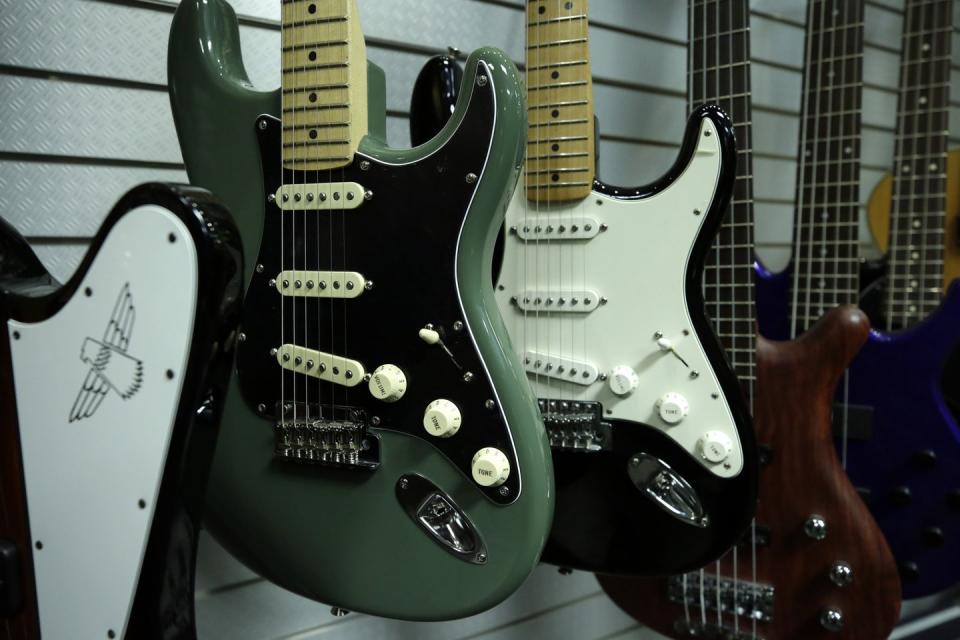Does an Electric Guitar's Paint Really Affect How It Sounds?

Does painting an electric guitar change the sound? It's a question that's been on the mind of the Smashing Pumpkins' Billy Corgan, who's been catching flak among gearheads on the internet for suggesting that paint color affects guitar tone. Corgan recently unveiled his signature model Reverend for Guitar Center, and said “I’ve found through the years that certain paints sound different, so the white Reverend, I think, sounds better.”
People who believe this idea typically talk about the type of finish used on a guitar, with nitrocellulose, polyester, and polyurethane being the three most popular. I buy into the notion that paint, like anything else you put on or in a guitar, will affect the tone, but I've found it difficult to get good answers on this topic, as a lot of the discourse is just forum talk full of speculation and contradictory answers.
To see if there’s credence to claims about guitar paint affecting tone, I talked to experts at the Fender Custom Shop and to Fender’s Senior Chemist Julio Cedano.
What Are Nitrocellulose Finish Guitars?

The opinion of guitar snobs writ large is that nitro, the original finish electric guitar manufacturers used in the U.S, is better at preserving the natural resonance of the wood in a guitar than polyurethane and polyester. When Fender was getting its start, their guitars were painted with DuPont ‘Duco’ nitrocellulose lacquer and DuPont ‘Lucite’ acrylic lacquer-the same paints used on General Motors automobiles. You had your Lake Placid Blue, your Candy Apple Red, Olympic White, and so on.
The same as paint protecting the metal frame of a car from damage, the paint on a guitar protects it from dings, scratches, and weathering. But nitro finishes dull over time and the paint chips off. There wasn’t UV protection in the lacquer so you’d get a yellowing effect. Polyurethane and polyester were adopted among guitar manufacturers in the late 60s/ early 70s as a more durable solution to nitro. Unlike nitro, these finishes gave guitars shiny veneers that wouldn’t fade over time and they wouldn’t chip or scratch as easily.
But to a lot of tone purists, they choked resonance on the guitars. The true, rich dynamics and frequency ranges of the wood were dulled and thus a lot of people eschewed polyester and polyurethane and still do to this day.
Fender Custom Shop’s Master Builder Ron Thorn offers some historical context: “Polyester got a bad rap in the late 60s, 70s, primarily because it was applied very thick. Now you can spray it almost as thin as Nitro at this point. Film thickness is a big factor, more so than the material. Tonally, if you keep it thin, they’re going to be very similar.”
A More Refined Poly
Over time manufacturers improved how they applied polyester and polyurethane to guitars, and now it's hard to say poly is inferior to nitro. If you love the vintage look-dings and all-and want to see the wood grain, go with nitro. If you prefer a glossier look and are really striving for durability, go with poly.
This is not to say poly and nitro produce no tonal differences. While Fender is naturally wary suggesting one finish they use sounds better than another, Cedano told that “laquer is more permeable and allows the wood to breathe and resonate more than the more durable polyester finish which can impinge a bit on resonance. It’s the balance of tone and durability.”
A thing that nitro proponents always bring up is that nitro never stops curing. It’s the same thing with concrete. Scientifically speaking, the solvents are continuously dissolving from the film and the fatty globs or emulsions containing the resin, pigments, and coalescing agents are left interlocked and bond with the wood and unto themselves and flatten out and flow into a uniform film.
Put simply, the paint thins out over time (hence the cracks you see on nitro finishes) and theoretically the resonance and tone are continuously getting richer, no matter how infinitesimal. A guitar with a poly finish cures within days, so setting aside the myriad of other wear and tear variables and just focusing on paint, a poly guitar will sound the same two years into owning it as it did within the first two weeks.
Color Correcting

Paint color affecting tone is what Billy Corgan critics are scratching their heads over. Unfortunately, it’s hard to find any tangible scientific discourse on the matter, but Fender was able to give me some insight.
I wondered if the different chemical makeups of distinct colors would affect the vibrations of the strings ricocheting off the wood. Because of their different chemical properties, Cedano explains, “different colors have different tint loads and need to be applied differently, some in greater amounts than others-so it would be more about a thin vs. thin finish rather than the color itself.”
It's likely that colors that need to applied more thickly would slightly stifle the resonance of the wood more so than colors with thinner films. Fender wouldn’t disclose which specific colors are painted thicker than others
So would the resin, pigments, and coalescing agents settle differently depending on the paint colors, affecting hardness, density, and porosity?
“Yes-this is the rationale behind the paint additives as dispersion, flow, viscosity control-these dispersion properties have a great impact on the mechanical properties as hardness and flexibility,” says Cedano.
This is where things get science-y. Young’s modulus of elasticity describes stress (density) over strain (the material moving and responding to stress) or more simply put-stiffness in an object. In a guitar, the wood and finish are coupled and since there’s a lot more wood than finish, the wood has greater effect on tone than paint. For an acoustic or hollow-body guitar the paint impacts tone more than it does on a solid body electric because the wood tops on these guitars are a lot thinner-roughly 1/10-inch thick as opposed to a 2-inch thick solid body.
So Does Color Affect Sound?
Quantifying how much paint effects tone is incredibly hard to answer because tone comes from the interaction of a lot of parts making up the whole-you can’t really isolate out one factor.
"Wood is a natural element and one board cut from the same tree could have a different resonant frequency than the one next to it," says Mike Lewis, Fender's VP of product development. "The only way to truly hear the difference between lacquer or poly or red or black or thick or thin is to completely build a guitar, paint it, and finish it in that color and then strip it down completely and repaint it with something else and listen to the same piece of wood, pickups and hardware side by side.”
Since paint has multiple functions on a guitar-it provides aesthetic, it protects the guitar from damage, it stabilizes the wood underneath, it makes up the outer layer in which sound waves emanate-paint manufacturers need to strike a balance in their designs-and they’re constantly evolving. Cedano says Fender has a state-of-the-art paint lab in Ensenada, Mexico, “with the most advanced chemical and microscopy instruments-such as ATR-FTIR-Microscopy, UV/Vis Spectroscopy, TGA-GC/MS and TMA.”
Of course, perceived differences in color on guitars could all just boil down to mojo. If you love a white guitar like Billy Corgan, you’ll be more in your element playing a white one than a red one. Me-I’m a sunburst guy. But whatever the answer, paint chemistry will continue in an endless quest to improve a guitar's tone.
('You Might Also Like',)

